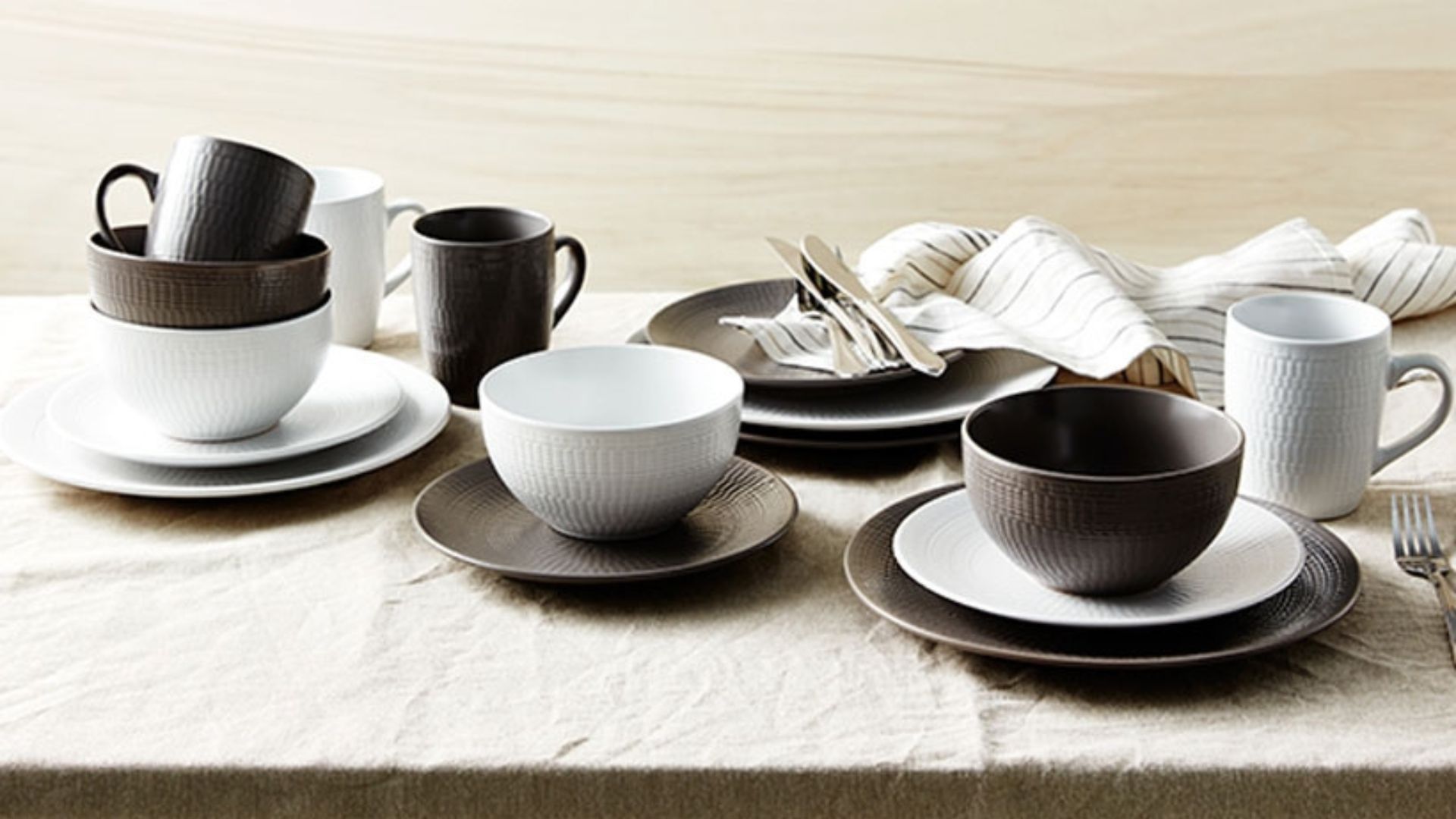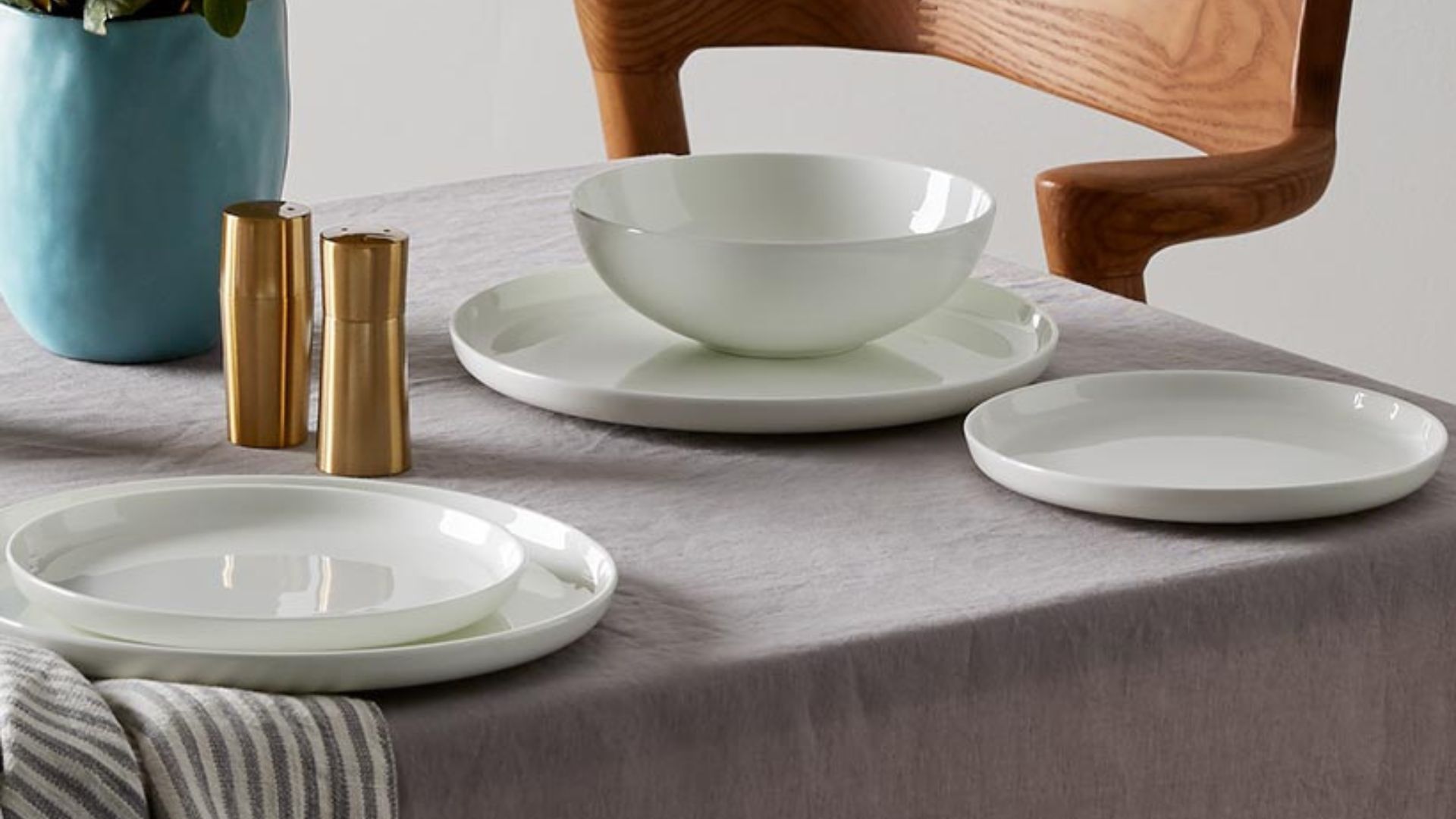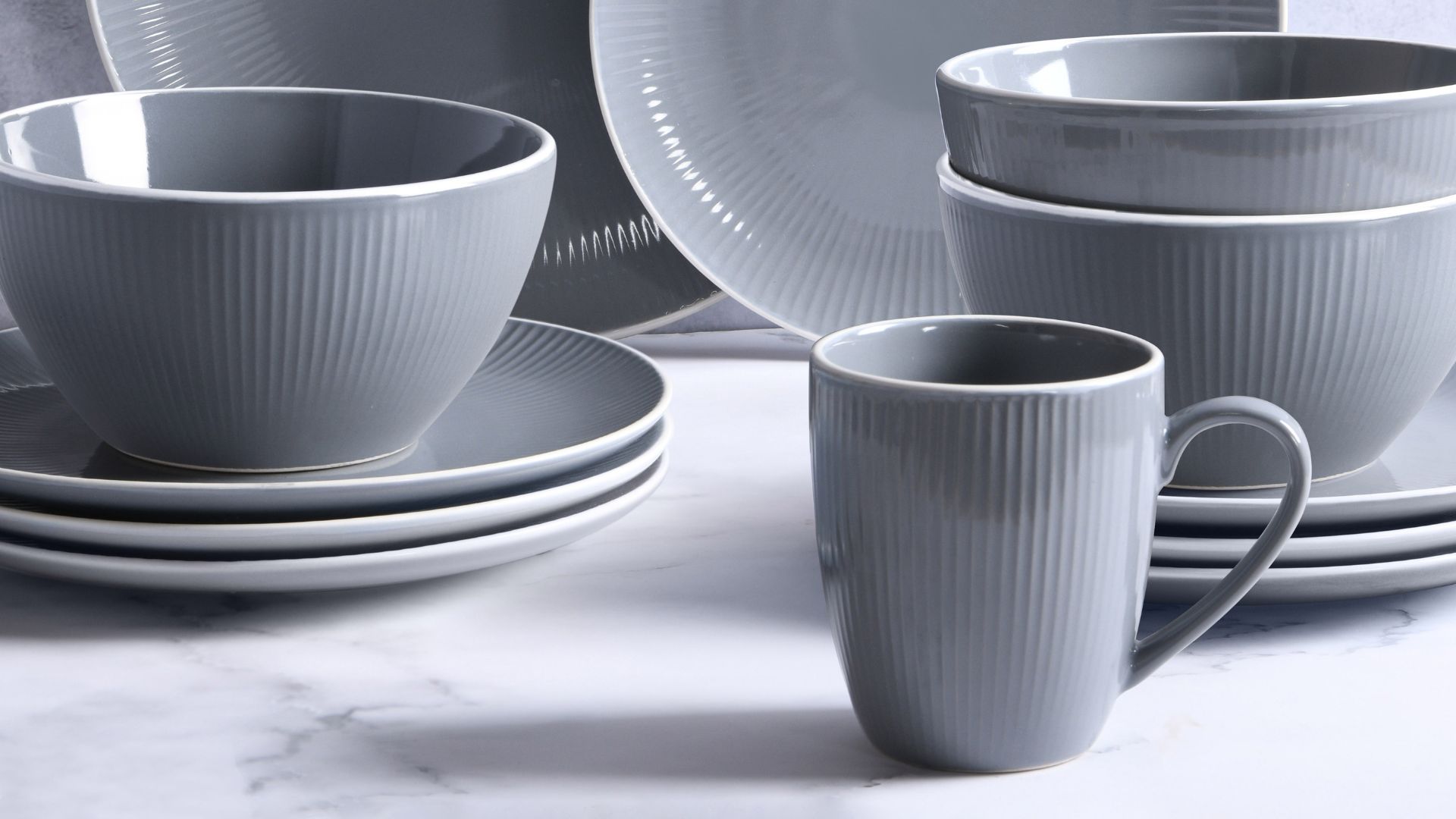| Your browser is not supported. | ||
|
Please browse our site using any of the following options:
| ||
Bone China vs Fine China vs Porcelain

If you are a discerning collector of fine dinnerware, you're undoubtedly familiar with the three most popular crockery materials: bone china, fine bone china, and porcelain. Each of these materials boasts unique characteristics and qualities, making them desirable. This article will explore the differences between these three materials and provide insights into the best option for you and your collection.
Quick Links
- Frequently asked questions
- What is bone china
- Benefits of bone china tableware
- How to wash and maintain bone china
- What is porcelain
- Bone china vs porcelain
- How to maintain porcelain
- How to buy bone china and porcelain for your home
- What is fine bone china
- Bone china vs fine bone china
- Invest in the best dinnerware at Harris Scarfe
Frequently Asked Questions
Why is bone china so expensive?
It's highly sought after due to its delicate texture and translucent quality, which makes it an ideal choice for fine dinnerware. The cost of bone china is high because of the materials and labour involved in its production. Making bone china requires multiple steps, such as mixing ingredients, forming, drying, firing, and glazing. These steps require time and skill, leading to a higher price tag for this luxurious item.
Is porcelain oven proof?
One of the critical features of porcelain is its ability to withstand high temperatures, making it an ideal material for ovens. When it comes to baking, porcelain can withstand temperatures up to about 572°F (300°C). This makes it perfect for use in ovens, as it can handle the heat of baking and roasting without cracking or breaking. It's also resistant to stains and odours, making it easy to clean and maintain. So, is porcelain ovenproof? Yes, it's a genuinely excellent material that is perfect for the oven. Its strength, durability, and resistance to heat make it an ideal choice for all your baking needs. Whether you are making a delicious pie, a savoury roast, or a batch of cookies, porcelain is the way to go!
Bone china or porcelain - which is better?
Between china and porcelain - the latter is more durable and feels heavier in your hand than bone china.
Define crockery and its different types
Crockery includes tableware items, like dishes, plates, and cups made from materials like earthenware, stoneware and porcelain. It's typically used for serving food and drinks and comes in various sizes, shapes and styles.
There are several different types of crockery available, including:
Earthenware
Earthenware is a type of clay-based ceramic that is fired at a low temperature. It is typically thick and porous and is often glazed to make it more durable and resistant to stains. Earthenware is relatively inexpensive and is often used for everyday tableware.
Stoneware
Stoneware is a clay-based ceramic fired at a higher temperature than earthenware, making it denser and less porous. It's typically more durable and resistant to wear and tear than earthenware. Often glazed to lend a smooth, glossy finish, stoneware is generally used for more formal occasions or as serving dishes.
Porcelain
Porcelain is often used for fine china and other high-quality tableware. We'll discuss what porcelain is and what porcelain is made of further in this guide.
Glassware
Glassware includes glasses, cups, and other tableware made from glass. It is typically transparent or translucent and used for serving drinks such as water, juice, and wine. Glassware can come in various styles, including stemware (glasses with a stem) and tumblers (glasses without a stem).
Metalware
Metalware includes dishes, cutlery, and other tableware made from metal, such as stainless steel, silver, or pewter. It is typically used for more formal occasions or as serving dishes.
Plasticware
Plasticware includes dishes, cups, and other tableware made from plastic. Ideal for everyday use or for events where disposable tableware is desired.
What is bone china?
Bone china is a type of fine Chinese porcelain made from animal bones. Making bone china is very labour-intensive and takes a lot of time and skill.
How do you identify bone china?
Identifying bone china can be tricky, as the material looks similar to porcelain and other types of ceramic. However, a few tell-tale signs can help you determine its authenticity. Look for a translucent appearance and a slightly greyish tinge. Secondly, when tapped with a fingernail, you'll be able to hear a clear ringing sound. Finally, when held up to the light, you should see some tiny flecks of animal bone in the material. It's important to note that bone china is more delicate than porcelain and needs careful handling.
What are the origins and history of bone china?
Bone china is a porcelain type that has been around since the 18th century and is made from kaolin, feldspathic material and bone ash. Bone ash, derived from the animal bones of cows, sheep, and horses, gives the porcelain its unique properties. This type of porcelain was first developed in England in 1748 by Thomas Frye, who used bone ash to create a more durable kind than previously available. Bone china became one of the most popular types of porcelain due to its strength and translucency. Today, it features in various products, including tableware, figurines, and decorative items.
Benefits of bone china tableware

There are a few benefits to choosing bone china as your tableware. It's elegant and luxurious that will make a statement at your dinner table. Bone china is highly durable and can withstand temperatures up to 1010 degrees Celsius. It can last through regular use and accidental slips and knocks, making it ideal for households with children. This makes it the perfect choice for those who want something that will last longer than standard porcelain. Finally, bone china is ideal for serving food in the light because of its translucency. Bone china is also likely to have sentimental value due to its ability to last for decades. Its perception of elegance and sophisticated taste makes eating a special occasion every day.
A few other benefits include the following:
- Oven safe
- Microwave safe
- Dishwasher safe
How to wash and maintain bone china
Washing bone china may seem intimidating initially, but with some care and attention, you can keep your bone china pieces looking beautiful for years.
First and foremost, it's essential to handle bone china gently to avoid chips or cracks. When washing bone china, use a soft sponge or cloth and a mild detergent. Abrasive sponges or harsh detergents can damage the delicate surface of the china.
It's also a good idea to rinse your bone china thoroughly after washing to remove any soap residue. You can gently pat the china dry with a soft, lint-free cloth.
If you have particularly delicate or ornate bone china pieces, consider hand-washing them to be extra cautious.
Maintain the beauty of your bone china by storing it properly. Avoid stacking your dinnerware, as this can cause chips or cracks. Instead, place each piece on a soft surface or in a china cabinet with padded shelves. By following these simple steps, you can keep your bone china looking as beautiful as the day you received it.
What is porcelain?
Porcelain is a delicate, refined, and elegant ceramic material known for its beauty, versatility, and durability. It's used to create fine china, figurines, vases, other decorative objects, and practical items like dishes, cups, and bathroom fixtures. Creating porcelain produces a hard, glossy surface resistant to wear, stains, and chipping.
What is china porcelain made of?
Wondering what is porcelain made of? Porcelain is a ceramic material composed of kaolin, feldspar, and quartz, purified and refined to create a smooth, white clay. Making porcelain involves several steps, including shaping and drying the clay, firing it at high temperatures, and glazing it with a glossy finish. The result is a stunning, translucent material prized for its strength, durability, and aesthetic appeal. While porcelain and fine china come from kaolin - the point of difference comes down to their firing temperatures. Porcelain has a higher firing temperature making it the more durable option. Its delicate beauty and enduring strength make it an aspirational material worthy of admiration and reverence.
Bone china vs porcelain
Bone china and porcelain are ceramic materials used to make various household and decorative objects. Both materials are known for their high-quality finish and are often associated with luxury and refinement.
However, some critical differences set them apart.
One of the main differences between bone china vs porcelain lies in their manufacturing process. The use of bone ash in the production of bone china gives it a unique combination of strength, beauty and translucent quality, making it a highly sought-after for fine tableware. Another difference between bone china vs porcelain is the way they are fired. Porcelain is fired at a much higher temperature than bone china, giving it a harder, dense, and more durable finish. However, this also means that porcelain is more prone to cracking and chipping than bone china.
In terms of appearance, bone china and porcelain are similar, but some subtle differences help you distinguish between the two. Bone china is typically lighter and has a more delicate, refined look. At the same time, porcelain can be slightly heavier and have a more formal or traditional appearance. Bone china and porcelain are excellent choices for high-quality tableware and decorative objects. They are often used interchangeably depending on the desired look and feel. Both materials are known for their beauty, durability, and versatility, and they are sure to add a touch of sophistication to any setting.
How to maintain porcelain?
Maintaining porcelain means treating it with the utmost care and respect, as it's a beautiful and delicate material that requires special attention. Here are a few tips:
- Handle porcelain with care: Avoid dropping or bumping porcelain items as they are prone to cracking and breaking. When washing porcelain, use a soft sponge or cloth to avoid scratching the surface.
- Protect porcelain from extreme temperatures: Avoid exposing it to hot or cold temperatures, as they can cause it to crack and break. For instance, don't put a cold porcelain dish into a hot oven or microwave or place a hot porcelain mug on a cold surface.
- Use the right cleaning products: Avoid using abrasive cleaning products or scouring pads on porcelain, as they can damage the surface. Instead, use a mild detergent or a specialised porcelain cleaner to wash and clean your items gently.
- Store porcelain properly: When not used, store porcelain items in a dry, cool place away from direct sunlight. Avoid stacking porcelain items, as they can cause them to chip and break.
How to buy bone china and porcelain for your home
If you're looking to elevate the style of your home dining experience - consider investing in beautiful bone china or porcelain dinnerware. These high-quality materials are renowned for their delicate beauty and durability, making them a timeless choice for any home.
To get started with the purchase experience - consider your style and the overall aesthetic of your home. Do you prefer a traditional look, or are you drawn to modern and contemporary designs?
Next, consider the size of your dinnerware set. How many place settings do you need? Do you entertain frequently, or is it just for everyday use? Make sure to purchase a set that meets your needs and has enough pieces to accommodate your guests.
Once you've narrowed your options, consider the quality of the bone china or porcelain. Look for pieces with a high percentage of bone ash, giving the dinnerware a more translucent and delicate appearance. Pay attention to the craftsmanship and construction of the pieces, as well - high-quality bone china and porcelain should be smoothly finished and feel sturdy in your hands.
Finally, don't be afraid to splurge a little on your dinnerware. These pieces are an investment that should last you for years, and using them to serve meals and entertain guests will add an element of luxury to your home. Whether you're hosting an elegant dinner party or simply enjoying a quiet meal at home - beautiful bone china or porcelain dinnerware will make every dining experience feel special.
What is fine bone china?
Fine bone china is a type of high-quality ceramic material with a delicate and refined appearance. Prized for its strength, translucency, and sheer beauty, it has a long and storied history going back centuries. Fine china is perfect for serving delicate foods, such as poultry or fish, and it's also oven safe.
How to identify fine bone china
To identify fine bone china, you can look for specific characteristics that distinguish it from other types of porcelain. For example, fine bone china is known for its thin, translucent walls, which give it a delicate, almost ethereal quality. It's typically also very smooth and glossy, with a subtle radiance that adds to its appeal.
Another way to identify fine bone china is to hold it up to the light. A thin blue line around the edges, also known as a "ring of fire," is a hallmark of high-quality bone china. In addition to these physical characteristics, fine bone china is often accompanied by a sense of prestige and exclusivity. It's often associated with luxury and refinement - owning fine bone china can symbolise sophistication and taste.
What's the history of fine bone china?
The origins of fine bone china can be traced back to 18th-century England when pottery manufacturers developed it to create a more durable and refined version of traditional porcelain. The key ingredient in fine bone china is bone ash, which is obtained from the bones of animals and mixed with other materials to create a strong and lightweight ceramic.
Fine bone china quickly gained popularity in Europe and beyond, thanks to its unique properties and elegant appearance. It became a symbol of refinement and luxury. It was often used to create intricate and ornate tableware, figurines, and other decorative items.
Over the centuries, fine bone china has continued to evolve and improve, with advances in technology and manufacturing techniques allowing for even more intricate and beautiful designs. Today, it remains a highly coveted material, prized for its timeless elegance and enduring quality.
Bone china vs fine bone china
Bone china is the pinnacle of the craftsmanship of ceramics. In contrast, fine bone china is a luxurious step up from that. The former features a mixture of kaolin clay, quartz, feldspar, and finely ground animal bones, which gives the material a beautiful, creamy white colour. It also lends it a unique translucency making it stand out from other materials. Fine bone china takes this one step further by adding a layer of fine porcelain to make it even more delicate and luxurious. Both are exquisite materials that will add sophistication to any space or occasion.
Invest in the best dinnerware at Harris Scarfe

Porcelain, bone china, and fine china are all elegant and refined choices for your tabletop. Whether you choose classic and traditional porcelain, delicate and refined bone china, or sophisticated and intricate fine china, you will impress your guests with your impeccable taste and attention to detail. With proper care, these timeless pieces will be a beautiful addition, adding a touch of luxury and refinement to every meal. Looking to update your dinnerware with the choicest range of bone china crockery? Harris Scarfe offers a comprehensive assortment of dinnerware sets from brands like Chyka, offering you options galore. If you love hosting friends and family, our table-setting tips and ideas won't disappoint. If you're looking for delicious recipes, don't forget to browse through our Food Hub today.